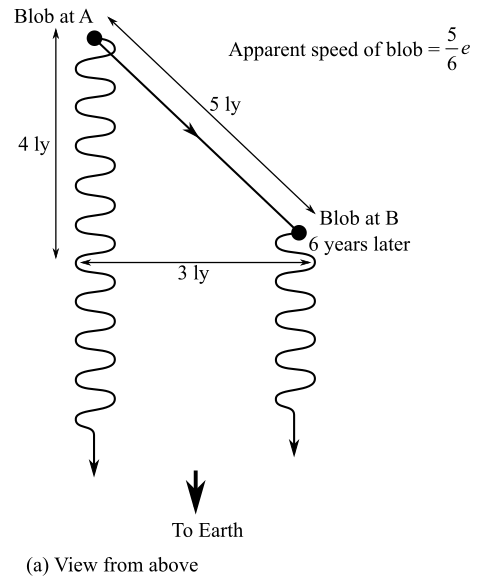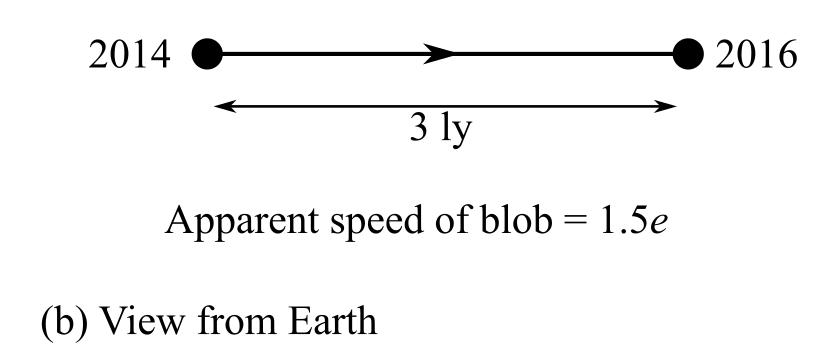
(a)
The time taken by the blob to move from A to B if the distance from point A to point B in the following figure is


(a)
Answer to Problem 16Q
Solution:
Explanation of Solution
Given data:
Distance between point A and point B is
Speed of the blob is
Blob moves toward Earth from point A through a distance
Blob moves in a side ways, transverse direction through a distance
Formula used:
The expression for the speed of any object is written as,
Here,
Explanation:
Write the expression for the speed of blob.
Rearrange this for
Substitute
Conclusion:
Therefore, the time taken by blob to move from A to B is
(b)
The year in which the light from B reaches Earth if the distance from A to point B in the following figure is

(b)
Answer to Problem 16Q
Solution:
Explanation of Solution
Introduction:
If any object appears to be moving faster than the speed of light, the motion of that object is called superluminal motion. Some astronomical objects such as quasars, blazars, radio-galaxies show superluminal motion.
Explanation:
It is given that the light from the blob at A reaches Earth in
Conclusion:
Therefore, the year in which the light from B reaches the Earth is
(c)
The apparent speed of the the blob moving across the sky as seen from the Earth if the distance from point A to point B in the following figure is

(c)
Answer to Problem 16Q
Solution:
The speed of the the blob moving across the sky appears to be 1.7 times the speed of light.
Explanation of Solution
Given data:
Distance between two points in the sky is
Time taken by light to travel from one point to another is
Formula used:
The expression for the speed of any object is written as,
Here,
Explanation:
Write the expression for the speed of blob.
Substitute
Conclusion:
Therefore, the apparent speed of the the blob is 1.7 times the speed of light.
Want to see more full solutions like this?
Chapter 24 Solutions
UNIVERSE LL W/SAPLINGPLUS MULTI SEMESTER
- How far does light travel in 1 year? [This distance, known as a light-year (ly), is used in measuring astronomical distances (Ch. 18.1).]arrow_forwardFigure P38.21 shows a jet of material (at the upper right) being ejected by galaxy M87 (at the lower left). Such jets are believed to be evidence of supermassive black holes at the center of a galaxy. Suppose two jets of material from the center of a galaxy are ejected in opposite directions. Both jets move at 0.750c relative to the galaxy center. Determine the speed of one jet relative to the other. Figure P 38.21arrow_forwardFigure P9.21 shows a jet of material (at the upper right) being ejected by galaxy M87 (at the lower left). Such jets are believed to be evidence of supermassive black holes at the center of a galaxy. Suppose two jets of material from the center of a galaxy are ejected in opposite directions. Both jets move at 0.750c relative to the galaxy center. Determine the speed of one jet relative to the other. Figure P9.21arrow_forward
- A light source recedes from an observer with a speed vS that is small compared with c. (a) Show that the fractional shift in the measured wavelength is given by the approximate expression vsc This phenomenon is known as the red shift because the visible light is shifted toward the red. (b) Spectroscopic measurements of light at = 397 nm coming from a galaxy in Ursa Major reveal a redshift of 20.0 nm. What is the recessional speed of the galaxy?arrow_forwardA light-year is the distance that light can travel in one year. Similarly, we can define a light-second, light-day, etc. as the distance that light can travel in other time intervals. Calculate the distance represented by each of the following: (Assume that the speed of light is 3 × 108 m/s). 1. 4 light-seconds 2. 3 light-minutes 3. 2 light-days 4. 2 light-days, but this time answer in miles (enter just the number with no units)arrow_forwardThe star 61 Cygni A is 11.4 light-years from Earth. Imagine a spaceship that travels from Earth to 61 Cygni A at a constant speed of 0.921c. On Earth, we would measure the time it takes for the ship to reach the star to be 11.4 ly 0.921c = 12.4 years. (a) How much time (in years) would it take the ship to travel from the Earth to the star as measured by a traveler aboard the ship? years (b) What is the distance to the star (in light years) as measured by a traveler aboard the ship? lyarrow_forward
- Galaxy A is reported to be receding from us with a speed of 0.35c. Galaxy B, located in precisely the opposite direction, is also found to be receding from us at this same speed.What multiple of c gives the recessional speed an observer on Galaxy A would find for (a) our galaxy and (b) Galaxy B?arrow_forwardChoose a unit distance in cm that would easily fit on a piece of paper. Let this be your scale distance, now divide your scale distance by 4.3 light years to get the scale that will allow you to convert between real distances and distances in your model. Scale = cm / 4.3 ly = cm / lyarrow_forwardA star is 80 light years from Earth. How fast does a spacecraft have to be for the journey to last the 70 years of an astronaut's life? The answer is 0,7526c. Show a complete approach on how to get to the answer by using the necessary equations.arrow_forward
- Im sorry but i cant understand this One light year =distance travelled by light in a year 1 ly=C(1 year) d= 12ly =12c years time taken by Fred and George with respect to observer on Earth are t1=dv1=12 c0.9 c=13.33 yrt2 =dv2=12 c0.5 c=24 yr Actual times are t0=t11-v1c2=5.81 yrt0=t21-v2c2=20.78 yrarrow_forwardA light-year is the distance that light can travel in one year. Similarly, we can define a light-second, light-day, etc. as the distance that light can travel in other time intervals. Calculate the distance represented by each of the following: (Assume that the speed of light is 3 x 10^8m/s) 5 light-minutes 6 light-days 6 light-days, but this time answer in miles (enter just the number with no units)arrow_forwardTwo waves are travelling through outer space. Wave 1 has a frequency of 300 MHz and wave 2 has a frequency of 300 Hz. How does the speed of wave 1 (v1) compare to wave 2 (v2)? a) v1 = (1E-6)v2 b) v1 = (1E6)v2 c) v1 = 1/v2 d) v1 = v2arrow_forward
 Modern PhysicsPhysicsISBN:9781111794378Author:Raymond A. Serway, Clement J. Moses, Curt A. MoyerPublisher:Cengage Learning
Modern PhysicsPhysicsISBN:9781111794378Author:Raymond A. Serway, Clement J. Moses, Curt A. MoyerPublisher:Cengage Learning Stars and Galaxies (MindTap Course List)PhysicsISBN:9781337399944Author:Michael A. SeedsPublisher:Cengage Learning
Stars and Galaxies (MindTap Course List)PhysicsISBN:9781337399944Author:Michael A. SeedsPublisher:Cengage Learning Classical Dynamics of Particles and SystemsPhysicsISBN:9780534408961Author:Stephen T. Thornton, Jerry B. MarionPublisher:Cengage Learning
Classical Dynamics of Particles and SystemsPhysicsISBN:9780534408961Author:Stephen T. Thornton, Jerry B. MarionPublisher:Cengage Learning Principles of Physics: A Calculus-Based TextPhysicsISBN:9781133104261Author:Raymond A. Serway, John W. JewettPublisher:Cengage Learning
Principles of Physics: A Calculus-Based TextPhysicsISBN:9781133104261Author:Raymond A. Serway, John W. JewettPublisher:Cengage Learning Physics for Scientists and Engineers with Modern ...PhysicsISBN:9781337553292Author:Raymond A. Serway, John W. JewettPublisher:Cengage Learning
Physics for Scientists and Engineers with Modern ...PhysicsISBN:9781337553292Author:Raymond A. Serway, John W. JewettPublisher:Cengage Learning Physics for Scientists and EngineersPhysicsISBN:9781337553278Author:Raymond A. Serway, John W. JewettPublisher:Cengage Learning
Physics for Scientists and EngineersPhysicsISBN:9781337553278Author:Raymond A. Serway, John W. JewettPublisher:Cengage Learning





